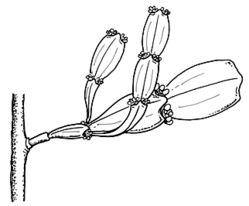Korthalsella rubra (Tiegh.) Engl. APNI* Synonyms: Korthalsella articulata Blakely APNI*
Korthalsella taenioides f. taenioides (Comm. ex DC.) Engl. APNI*
Korthalsella taenioides (Comm. ex DC.) Engl. APNI*

Description: Plant usually to 16 cm high, branched several times at lower nodes with unbranched extremities up to 12 internodes long; branches mostly flattened transversely to parent stem; internodes contracted at ends and strongly articulated at nodes, ± narrow-cuneate, usually 10–18 mm long and 3–8 mm wide, attenuate at base, so that individual internodes are the visually distinct units of all stems.
Distribution and occurrence: Parasitic on a broad range of hosts in rainforest to semi-arid woodland.
NSW subdivisions: NC, CC, ?SC, NT, CT, ?ST, NWS, CWS, ?SWS, NWP, SWP, LHI
Other Australian states: Qld Vic.
Text by A. L. Quirico
Taxon concept:
| | Key to the subspecies | |
| 1 | Floral cushions not protruding, but with visible sparse, long red hairs which are mostly in a single row between flowers Rudimentary leaves 0.5–1 mm high, membranous, usually obtuse, together continuous around node and almost continuously free except fusion to face of internode at its midpoint. Flowers almost completely encircling node in early stage, separating as internode expands. Flowers chiefly spring. Parasitic on a wide range of trees in rainforest and wet sclerophyll forest | subsp. rubra |
| Floral cushions protruding in older, and longer than flowers in younger inflorescences, with a dense mass of white hairs; flower clusters separated by a distinct triangular area of internode surface. Rudimentary leaves distinct only around flower clusters, acute, tapering from 0.5 mm high at outer limit of floral cushion to 0.2 mm high at inner limit together extending across face of internode between flower clusters as a rim 0.2 mm wide and not spreading, which are distinct at all stages. Flowers throughout year. Parasitic mostly on Geijera parviflora. | subsp. geijericola |
APNI* Provides a link to the Australian Plant Name Index (hosted by the Australian National Botanic Gardens) for comprehensive bibliographic data
***The AVH map option provides a detailed interactive Australia wide distribution map drawn from collections held by all major Australian herbaria participating in the Australian Virtual Herbarium project.
|


